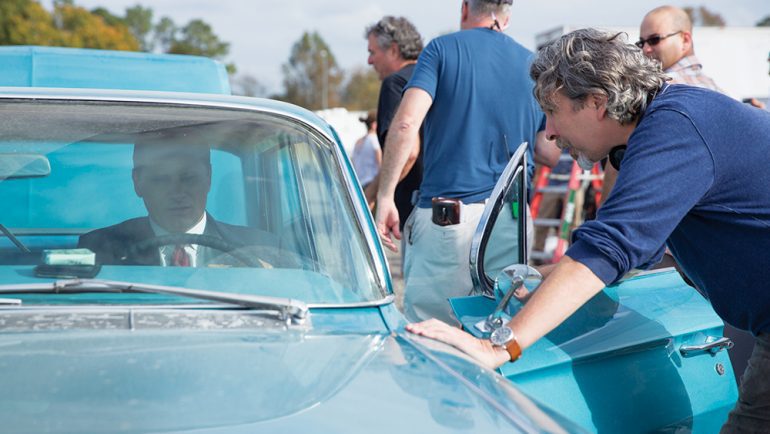‘Green Book’ Director Peter Farrelly on His Production Crew’s Drive for Authenticity
By Tim Gray
LOS ANGELES (Variety.com) – “Green Book,” which Universal releases Nov. 16, centers on the unlikely real-life friendship between Jamaican-American classical pianist Don Shirley and his driver Tony Vallelonga, a laid-off New York nightclub bouncer, during a 1962 tour of the Midwest and the racially tense South. The film premiered at the Toronto Intl. Film Festival in September and has surged to become an Oscar contender, including possible actor noms for the two leads, Mahershala Ali and Viggo Mortensen.
Director-co-writer Peter Farrelly, best known for offbeat comedies (“There’s Something About Mary”), says it was a tough production: “We had 35 days and $20 million to shoot this 120-page script — and with dozens of locations, all set in 1962.” The result looks effortless, partly because of the cast and crew: “A lot of people did a lot of work for very little money because they liked the story.”
Sean Porter, Cinematographer
“I’m a story guy, so I wanted a visual balance. As a director, you want to cut your DP loose. And his films like ‘Kumiko, the Treasure Hunter’ are gorgeous. So I asked him, ‘Can we get your look on this budget?’ I like the look he got. The colors made you feel like it’s 1962. That wasn’t something in post-production; it’s the way he lit it and shot it. The driving stuff was a challenge, with lots of conversations in the car. There are only so many angles you can use. You don’t want to get redundant. Sean and I wrote down every angle for each car scene and mapped it out.”
Tim Galvin, Production designer
“We were constantly moving. We filmed the whole thing in Louisiana, except for one day just outside of New York City. The hard part was finding places to double for Pennsylvania, Ohio, Iowa, the Bronx. And of course you can’t shoot scenes in order; it’s too expensive. Plus we had to be very careful about the leaves on the trees. We shot scenes of Don Shirley performing in maybe 15-16 theaters, with three or four a day sometimes. For Tony’s apartment in New York, Nick Vallelonga [the son of ’s character and author of the book on which the film is based] brought in photos from his home and that era. We built very few sets. I think the most fun for Tim was Don Shirley’s apartment above Carnegie Hall, with all those knickknacks and the throne. One of the most satisfying moments was when we did a screening for Dr. Shirley’s friends from those days, and they said, ‘That’s exactly his apartment!’”
Patrick Don Vito, Editor
“Usually with a movie, the first assembly makes you want to throw up, but eventually you get there. With Patrick, it was there from the first assembly, just minor tweaks. I started telling people, ‘This movie is editing itself!’ and then I realized, ‘No, you idiot, Patrick is so good he just makes it look like the film is editing itself.’ He gets what was on paper, and he can translate it well. A lot of editors can’t. You want it to feel seamless, to look like it did on the page, for him to put together what you wrote. With Patrick, it was perfect.”
Betsy Heimann, Costume designer
“Betsy saved the day. She’s done a lot of big movies, and I said, ‘I think you’re great, but we don’t have any money.’ She said, ‘I’d do this for free. I want to do this.’ She probably took a loss by doing this movie. She found old stuff, and the most fun was dressing Dr. Shirley. His outfits were unbelievably great. Dr. Shirley was elegant; that was important. We did screen tests because Sean wanted to see how they would light. Each time Mahershala [Ali] would walk on the set looking so terrific, I’d say to Betsy, ‘You’re going to steal that when we wrap, right? You should.’”
Rick Montgomery, Casting director
“He did a lot of work. Rick was the first guy on board. He was contacting agents and managers while working for nothing; we didn’t even know if we had the money for a movie. These are the unsung heroes of the industry. Rick helped us get to Viggo and Mahershala before we even had a movie. And Linda Cardellini [who plays Mortensen’s wife] was a feather in Rick’s cap. She was perfect for the role. Most of the actors were from the Louisiana area. Casting is my least favorite part of moviemaking; you say no to 99 people and yes to one. Often they’re all good, but you have to pick one. That’s tough for everyone.”
Kris Bowers, Music
“The film centers on Don Shirley’s piano playing, so we thought, ‘Let’s use other instruments when we can.’ So Kris composed for a full orchestra. The scene in the first hotel — everyone is on the balcony at night — it’s a really sad scene, and Kris’ music is so important. He also worked with our music supervisor, Tom Wolfe, and did some of the piano playing as a double for Dr. Shirley. While we were setting up shots, he’d play for the audience and they’d go nuts. He worked with Mahershala to get comfortable at the piano. Early on, we did research and asked, ‘Who’s the best pianist around?’ Kris’ name always came up. He was confident and easy to work with. He doesn’t come in like an artiste.”

